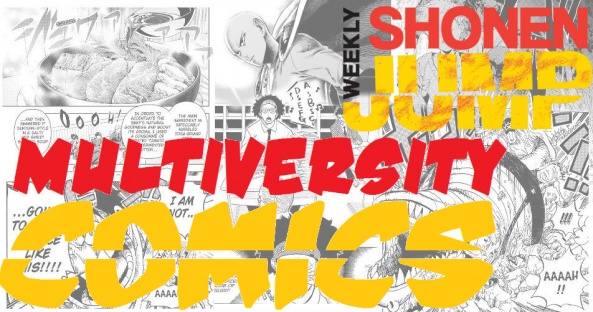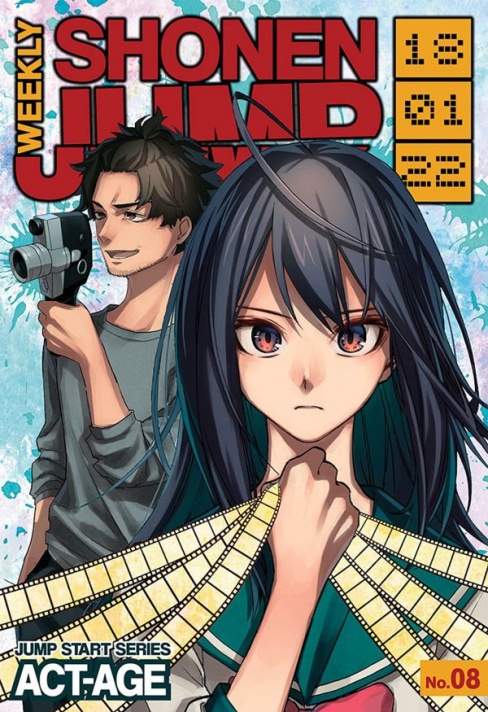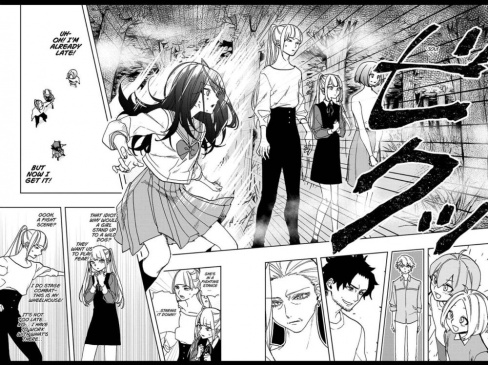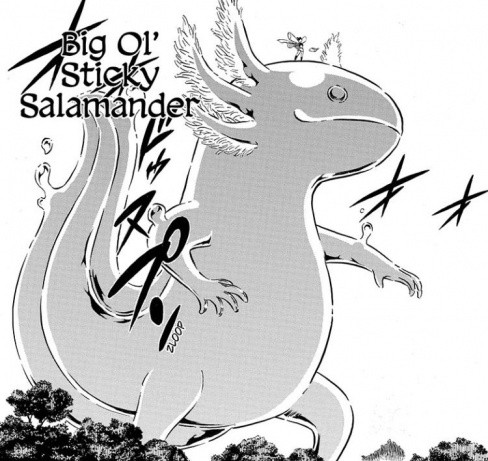
Welcome to This Week in Shonen Jump, in which a rotating duo of Multiversity staffers take a look at two stories contained in each installment of Viz Media’s Weekly Shonen Jump. For the uninitiated, Weekly Shonen Jump is an anthology that delivers more than 200 pages of manga of all varieties. We hope that you’ll join us in exploring the world of Weekly Shonen Jump each week. If you are unfamiliar, you can read sample chapters and subscribe at Viz.com.

This week, Rowan and Matt to check in with “Black Clover” and “Act-Age.” If you have any thoughts on these titles, or “The Promised Neverland,” “Food Wars,” “We Never Learn,” “Robot X Laserbeam,” “Bozebeats,” “Dr. Stone,” “Boruto,” “Yu-Gi-Oh,” or “My Hero Academia,” let us know in the comments!

Act-Age Chapter 1
Written by Tatsuya Matsuki
Illustrated by Shiro Usazaki
Review by Matt Lune
“Act-Age” is the latest Jump Start series coming from “Shonen Jump,” and the focus for this Hero’s Journey is a lot more grounded than most Shonen Manga outside perhaps sporting manga: acting. The rise to superstardom shares a lot of traits with the stereotypical Shonen story structure, thrusting the poor, good hearted nobody Kei Yonagi into the spotlight and beginning her journey to what one can only assume will be to become the greatest actor of her generation.
If you read other “Shonen Jump” regulars like “Robot x Laserbeam” or “Food Wars,” you can notice the same style that’s on display here: namely that as you navigate through the protagonists trials, little asides will explain the importance of the scoring or type of golf club used (“Robot x Laserbeam”), the immense and improbable skill needed to pull off such a culinary delight (“Food Wars”), or in this case, just how talented and somewhat dangerous method acting is.
So while the structure is in place in this debut chapter, what’s still left ambiguous is just how hard they are going to lean into the idea of method acting being a dangerous skill to possess. Kei Yunagi has had a tragic life so far, as we find out her father abandoned the family, her mother died, and she has been left to be the sole carer for her younger brother and sister Rui and Rei. Consequently, Yunagi will lose herself, quite literally, in movies and the characters within, to the point where, if she’s feeling sad she will watch a movie that reminds of happier times and “act” happy.
This adds a fascinating edge to the ongoing story, one that could potentially delve into what it means to be an introvert and how maintaining a consistent outward personality is something many of us do to hide what’s really going on inside. There’s a moment where Kei’s younger sister Rui is scared of her because her personality has changed overnight. Similarly, the casting agent is reluctant to cast Kei because she’s worried about her mental health, claiming that becoming a different person is a “terrifying skill.” There’s an underlying point in “Act-Age” that if you devote yourself so fully to becoming someone else, who even is the real you?
Usazaki’s art is clean and crisp, deciding to drop a lot of background detail entirely to spotlight the characters. It’s a smart decision, as not only does it make the characters feel like they’re onstage at a play (aka acting), but also drives the focus of the reader toward the emotional beats of the characters, matching the driving purpose of the narrative. It also works as contrast for those times, such as later in the chapter, where Kei is deep in “the method,” and, in this example, an empty room becomes a forest as she imagines facing off against a feral dog.
Levity is added by having Kei’s younger siblings often portrayed in a chibi style, but there’s a reliance on realism, especially in the facial expressions, that’s essential for the plot. “Act-Age” chapter 1 is a strong start to what promises to be a surprisingly nuanced Shonen Manga, about the cost of letting your personality be dictated by others, and what it means to lose yourself in disingenuous emotions.
Continued belowFinal Verdict: 8.6 – “Act-Age” tackles the complex subject of identity in a unique and fascinating way. A great start to a new series.

Black Clover Chapter 141
Written and Illustrated by Yuki Tabata
Reviewed by Rowan Grover
In my time reading “Black Clover”, it’s become clear to me that this is a title that embraces the best of old-school Shonen and infuses it with modern, anything-goes style manga. This chapter whole heartedly represents this idea. Yuki Tabata has all his heavy hitting characters push their powers to their logical extremities. Henry, the slacker-looking type, gets a chance to shine as Tabata essentially has him rearrange the Black Bulls’ base into a giant mecha. It’s absurd action at it’s finest as Mikael Caesar struggles against it, but it’s from here that you get to truly see how much fun Tabata is having with these ideas of his. Sally from the Eye of the Midnight Sun uses her power to create an equally huge gel-skinned axolotl called ‘Big Ol’ Sticky Salamander’ to face off against Henry in the epic Mecha/Kaiju battle we never knew we needed in “Black Clover”. It’s balls to the wall plotting, making for some great pacing and removing any chance of a dull moment.
You might have gauged from all of this that this might have been more of an action-over-content type of chapter, and on most levels, it is. But there’s some neat character moments too that give us an insight into motives. The star of the show, Henry, has previously been something of an enigma since his introduction in chapter 99. But now we get a taste of his backstory and of how his relationship with the Black Bulls began. Tabata gives it enough real estate to make it worthwhile, but holds off on it so as not to overload us, and keep the intrigue running for the long-term readers. But we also get a bit of his motivation and how he really feels about his relationship with the rest of the team. We get that there’s a good rapport with him and the team even though he’s never been a huge player until now, as Tabata has characters like Gauche and Grey complement Henry’s powers to help him defeat the Midnight Sun. It’s your classic friendship trumps all manga theme, but it’s used sparingly enough here that it’s meaningful.
In the past I’ve felt that sometimes the balance between Tabata’s flagship eastern fantasy art style and the typical overly comedic manga art style has been a little impaired. I’m a firm believer that the latter needs to be used sparingly and that humour can be conveyed just as well in a normal art style, and thankfully Tabata works great with this in mind in chapter 141. It’s in part thanks to the super-fun tone of the script that this works in a kind of deadpan way. From the first page, we see that Henry’s turned the Black Bull’s base into a giant pseudo-mecha, which on its own is super impressive artwork, but the way that it looms awkwardly on the page seems to consistently inspire a laugh whenever I flick past it. Regarding the overly-comedic style, it works here because it’s used strongly only once, when the Black Bulls literally verbalise how the audience is reacting to the scene with ‘WHAT IS THIS CRAZY MAGIC?!!’.
Tabata’s action, especially with the script in mind, is for the most part highly kinetic and super fun. Surprisingly, I think that this is driven by the smaller, actual-people-focused action scenes rather than the mecha/kaiju action. Tabata draws his figures constantly in motion, never feeling static or posed. When the Black Bulls run around the battlefield trying to help Henry, it drives the action forward since it’s hard to convey that silky smooth sequential narrative with such gigantic, stoic characters. But when they do clash, it feels like a great payoff, sort of like the people running around inbetween is a musical crescendo to the accented chorus of the titans ramming each other across the battlefield. My only qualm with the action in this chapter is that I find the whirlwind magic to be tedious and hard to follow. It’s certainly a cool powerset for Mikael to have, but it just feels like lazy filler art on Tabata’s part to speed up the artistic process.
“Black Clover” is the perfect kind of modern and classic Shonen Jump manga fusion, and chapter 141 cements this idea. With a battle between a weaponised mecha base and a gigantic gel amphibian lifeform, some light shed on one of the more interesting characters and even more bonds formed – this has been one of the bigger chapters in some time. Jump on now while it’s still easy to catch up.
Final Score: 8.8 – “Black Clover” embraces absurdity with its high-paced action and well executed character moments.






